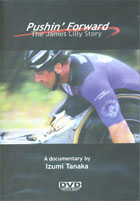
Pushin' Forward. The James Lilly Story 2007
Distributed by Fanlight Productions, 32 Court St., 21st Floor, Brooklyn, NY 11201; 800-876-1710
Produced by Izumi Tanaka
Directed by Izumi Tanaka
DVD, color, 40 min.
College - Adult
Health Sciences, Psychology, Social Work, Disability Studies
Date Entered: 12/12/2007
Reviewed by Lori Widzinski, Health Sciences Library, University at Buffalo, State University of New YorkThis is the inspirational story of James Lilly Jr. and how he went from gang member to champion wheelchair racer. Growing up in Chicago’s southwest side, on the borderline between black and Mexican neighborhoods, James learns early that survival on the streets means joining a gang. He was a rising star, becoming deeply entrenched in gang life—painting graffiti murals, selling drugs, mugging people; until one day James and his best friend were shot in a street confrontation, paralyzing James from the waist down and killing his friend.
James continued to go deeper and deeper into a life of drugs and crime after his accident. Known to the police as a “heartless little punk,” he hits bottom before turning his life around to become a champion wheelchair racer, a loving husband, father, son, brother, and an anti-gang spokesman to school kids. Interviews with James’ family (particularly his mother and brother) and a scene of James returning to speak at his old school are particularly moving.
Filmed in a style reminiscent of cinéma vérité, director/producer Izumi Tanaka shows us the face of true determination as James meets a goal of winning the longest wheelchair race in the world, the Sadler’s Midnight Sun Ultra Challenge, between Fairbanks and Anchorage Alaska. Although well made, there are a few “shaky camera” shots that are dizzying, but they are short-lived and do not mar this otherwise technically fine production.
Pushin’ Forward not only profiles James Lilly Jr., but gives us a brief glimpse of life for, and with, a disabled athlete. He “tells it like it is” in his school talks and Tanaka has done the same in his film. It is a perfect example of channeling the energy of a competitive, loving spirit from the negative side of life to the positive. Recommended for academic health sciences libraries and other specialized library collections focusing on disabilities.